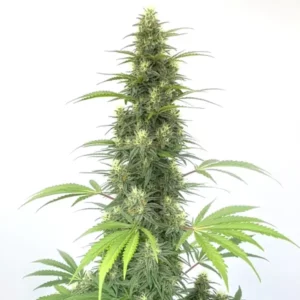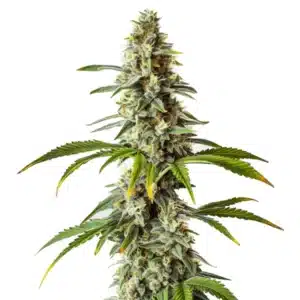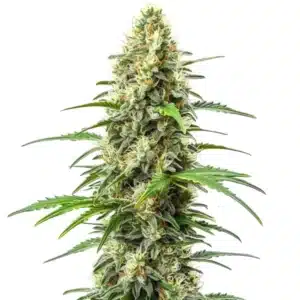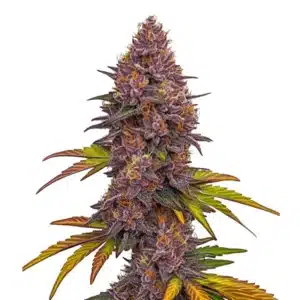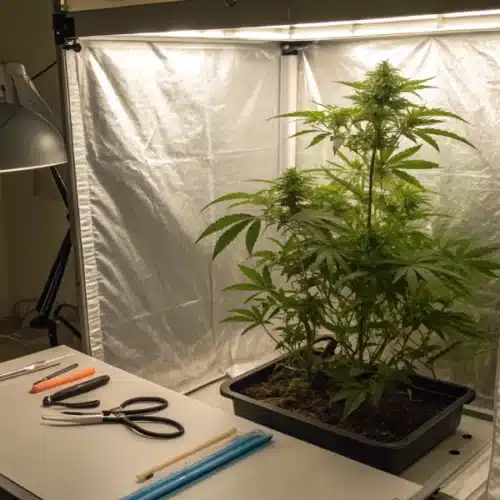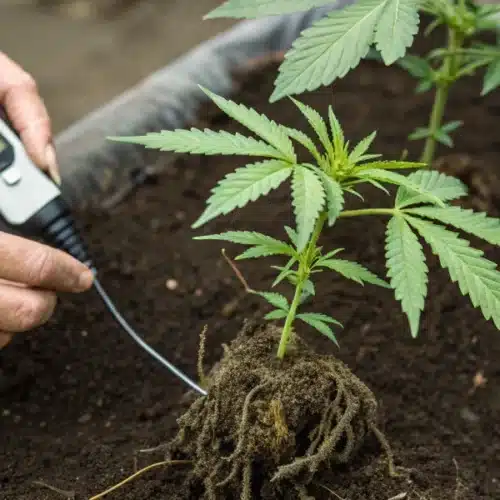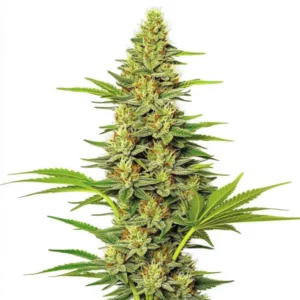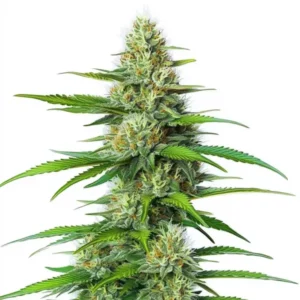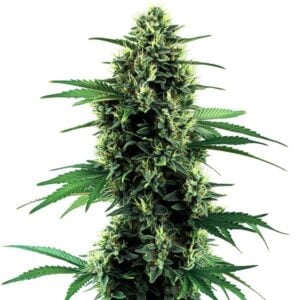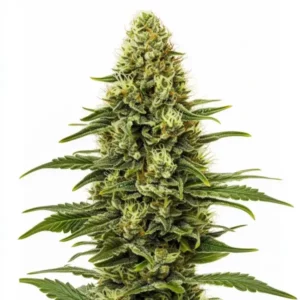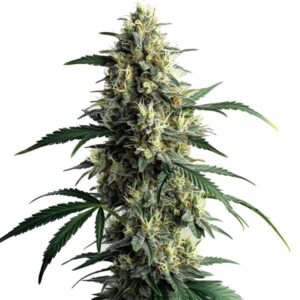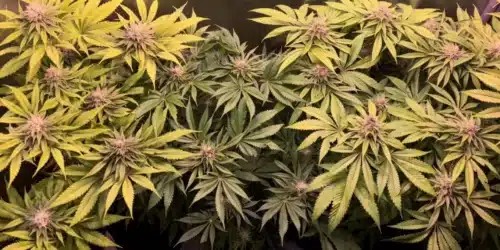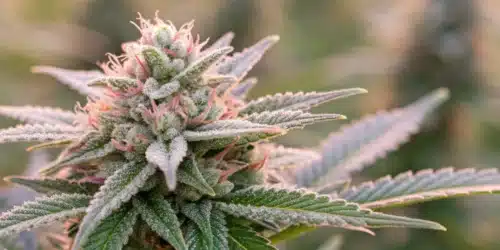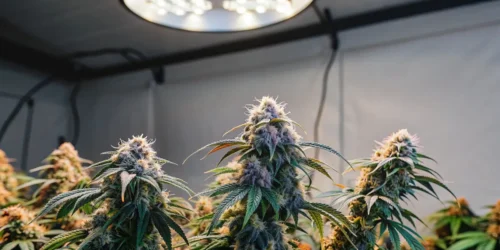White Widow x Northern Lights Strain Description
White Widow x Northern Lights Strain is a remarkable hybrid, blending two legendary cannabis strains into one powerful plant. This strain combines the energetic, uplifting properties of White Widow with the calming, body-focused effects of Northern Lights. Known for its balanced high, this strain is perfect for both recreational users seeking relaxation and medicinal users looking for symptom relief.
Recommended Strains
White Widow x Northern Lights
 THC: 18% - 20%
THC: 18% - 20% Type of seed: Feminized
Type of seed: Feminized Phenotype: Mostly Sativa
Phenotype: Mostly Sativa Day to flower: 8 - 10 weeks
Day to flower: 8 - 10 weeks
The strain showcases tightly packed, frosty buds with a shimmering coat of trichomes. Colors range from deep green to subtle hues of purple, enhanced by bright orange pistils. Its complex terpene profile delivers earthy, fruity, and sweet notes, creating a rich sensory experience. These features have made it a sought-after strain among both novice and seasoned cultivators.
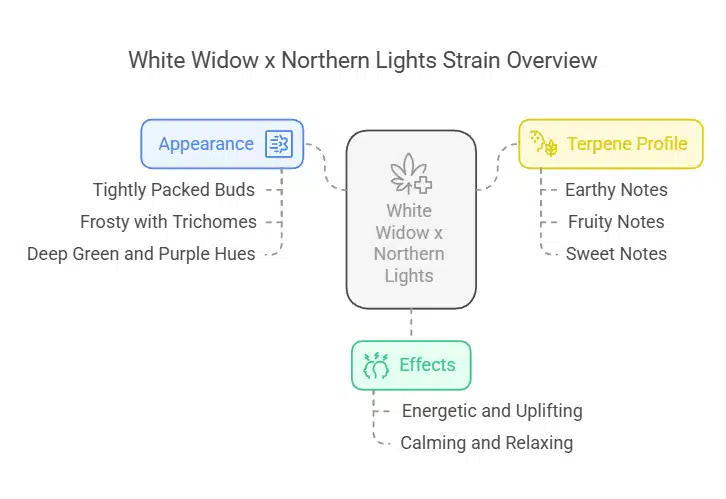
Promos & Deals
Environmental Requirements for Growing White Widow Northern Lights
To maximize growth and yields, it is important to provide White Widow Northern Lights Strain with the right environmental conditions. This strain thrives in moderate climates, with daytime temperatures ideally between 70°F and 80°F (21°C to 27°C). Slightly cooler temperatures at night can encourage better resin production, enhancing the strain’s potency.
Humidity levels should be maintained between 40% and 60% to prevent mold and mildew. Adequate air circulation is essential, especially in indoor setups. A combination of oscillating fans and a well-designed exhaust system helps regulate both temperature and humidity. For outdoor growers, selecting a location with ample direct sunlight is key to ensuring robust plant growth.
Providing the right soil or medium is also important. A well-aerated, nutrient-rich substrate with a balanced pH level between 6.0 and 6.5 will optimize nutrient uptake and overall health.
Setting Up the Growing Cannabis Space
Indoor Cannabis Cultivation
For indoor cultivation, growers should invest in a high-quality grow tent or dedicated grow room. The space must allow sufficient room for plants to grow both vertically and horizontally. High-intensity grow lights, such as LED or HPS, are necessary to support both vegetative growth and flowering. Reflective materials like Mylar help maximize light distribution across the canopy.
Ventilation is crucial to prevent heat buildup and ensure fresh air exchange. Equip the grow space with an exhaust fan and carbon filter to manage odors and humidity effectively. Maintaining a light schedule of 18 hours of light per day during the vegetative stage and switching to 12 hours during flowering will optimize growth stages.
Outdoor Cannabis Cultivation
Outdoor growers should select a sunny location with well-draining soil enriched with organic matter. If the soil quality is poor, consider using large containers filled with nutrient-rich potting mix. Protective measures, such as trellises or stakes, are helpful to support the plant’s structure as heavy buds develop. Additionally, shielding the plants from extreme weather, including strong winds and heavy rainfall, ensures healthier growth.
Propagation and Germination of White Widow Northern Lights
Starting your grow with healthy, feminized seeds is crucial for success. White Widow x Northern Lights seeds can be germinated using several methods, including the paper towel method or direct planting in a seedling tray. Maintain a warm, dark environment with temperatures around 75°F to 80°F (24°C to 27°C) to promote successful germination.
Once the seeds sprout taproots, carefully transfer them to your growing medium, keeping the roots undisturbed. Provide indirect light during the early seedling stage, gradually increasing light intensity as the plants grow. Maintaining proper moisture and airflow prevents damping-off, a common problem at this stage.
Vegetative Phase of White Widow Northern Lights Strain
During the vegetative phase, plants develop their structure, focusing on leaf and stem growth. Ensure the plants receive 18-20 hours of light per day, supplemented by high-quality grow lights. Nutrient-rich fertilizers with higher nitrogen content are essential to support this vigorous growth.
Water the plants regularly but avoid overwatering. Allow the top layer of soil to dry slightly between waterings. Training techniques such as topping and low-stress training (LST) can help control plant height and improve light penetration, promoting an even canopy and greater bud development.
Flowering Phase of White Widow x Northern Lights Strain
White Widow Northern Lights enters the flowering stage once the light schedule is reduced to 12 hours of light and 12 hours of darkness. This phase typically lasts 8 to 10 weeks. During this period, the plants will produce dense, resinous buds covered in trichomes.
Transition to a phosphorus and potassium-rich bloom nutrient formula to enhance flower production. Maintaining a slightly lower temperature range of 65°F to 75°F (18°C to 24°C) helps increase resin and terpene production. Monitoring humidity levels and ensuring proper ventilation reduces the risk of mold and bud rot.
Harvesting and Curing White Widow Northern Lights
Harvest timing is critical to ensure maximum potency and flavor. Monitor the trichomes using a magnifying tool. When most trichomes appear milky with a few amber ones, it is the optimal time to harvest.
Cut the branches carefully, removing large fan leaves while preserving the sugar leaves. Hang the branches upside down in a dark, ventilated area with temperatures around 60°F to 70°F (15°C to 21°C) and humidity between 50% and 60%. Proper airflow prevents mold formation.
After drying for 7 to 14 days, transfer the buds to airtight jars for curing. Burp the jars daily during the first week to release excess moisture. This process enhances the flavor, aroma, and overall quality of the final product. Curing can last from 2 to 8 weeks depending on your preference.
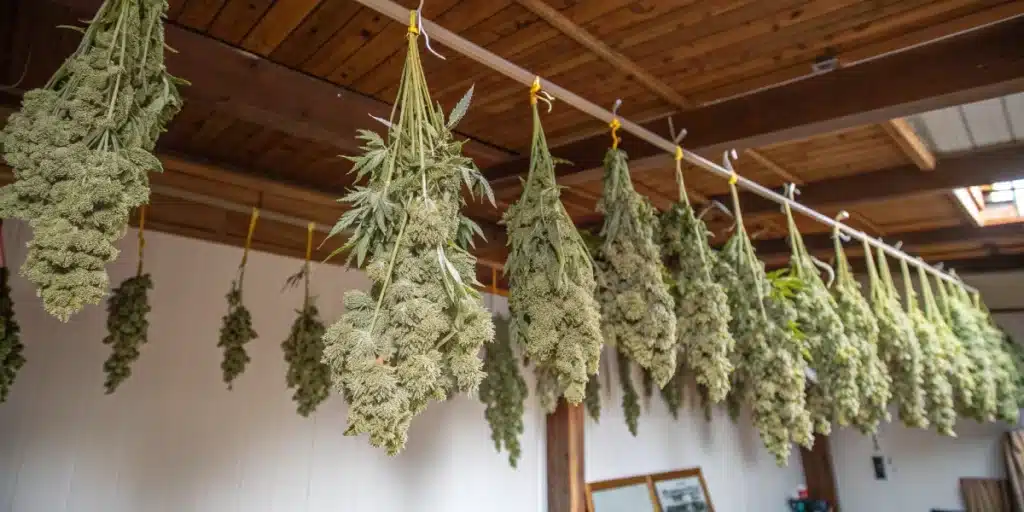
Cannabis Fertilization and Nutrition
Providing balanced nutrition throughout the growth cycle is essential for achieving optimal yields. During the vegetative stage, focus on nitrogen-rich fertilizers. As the plant enters the flowering stage, shift to bloom-specific nutrients with higher phosphorus and potassium content. Micronutrients such as calcium and magnesium also play a vital role in healthy development.
Monitor your plants regularly for signs of nutrient deficiencies or excesses. Adjust the feeding schedule as necessary, and always follow the manufacturer’s recommendations to prevent overfeeding or nutrient lockout.
Pest and Disease Control for Cannabis Growing
Although White Widow Northern Lights is known for its resilience, pests and diseases can still pose challenges. Regular inspections help detect issues early. Common pests include spider mites, aphids, and thrips. Introducing beneficial insects like ladybugs can help manage pest populations naturally.
Maintain clean growing conditions by removing debris and dead plant material. Proper ventilation reduces humidity levels, minimizing the risk of fungal infections such as powdery mildew and botrytis. If infestations occur, use organic pest control products to protect your plants and harvest quality.
Common Mistakes When Growing White Widow x Northern Lights
Several mistakes can hinder the success of your grow. Overwatering is a frequent issue that can lead to root rot. Allow the soil to dry out slightly between waterings to avoid this problem. Incorrect light schedules, particularly during the flowering stage, can also disrupt bud development.
Another common error is neglecting to monitor nutrient levels. Excessive feeding can result in nutrient burn, while deficiencies can stunt growth. Regularly check your plants for signs of stress, and adjust your care routine accordingly.
Similar Strains to White Widow Northern Lights
White Widow
White Widow is a classic strain known for its potent, uplifting effects and resinous buds. It shares similar genetics and provides a euphoric high that enhances creativity and energy.
Northern Lights
Northern Lights is a pure Indica strain famous for its relaxing, full-body effects. It offers a calming experience ideal for unwinding after a long day, making it a complementary counterpart to White Widow.
Blue Dream
Blue Dream is a balanced hybrid with a reputation for delivering both mental stimulation and physical relaxation. Its sweet berry flavors and high THC content make it a popular alternative for growers seeking variety.
Tips for Professional Growers
Professionals can enhance their yields by implementing advanced techniques such as SCROG (Screen of Green) or SOG (Sea of Green) to optimize light distribution. Regularly calibrating environmental controls, including CO2 enrichment, can boost growth rates and resin production.
FAQs About White Widow x Northern Lights
How long does White Widow Northern Lights take to flower?
This strain typically flowers within 8 to 10 weeks, depending on environmental conditions and cultivation methods.
What is the ideal climate for growing White Widow Northern Lights?
A moderate climate with temperatures between 70°F and 80°F (21°C to 27°C) and humidity levels around 40% to 60% is ideal.
Can beginners grow White Widow x Northern Lights?
Yes, this strain is suitable for beginners due to its robust nature and moderate cultivation difficulty.
What are the medical benefits of this strain?
White Widow Northern Lights may help alleviate symptoms of arthritis, insomnia, and pain, thanks to its balanced cannabinoid profile.
What type of lighting is best for indoor cultivation?
High-intensity LED or HPS grow lights are recommended to ensure optimal light penetration and plant health.
Why Buy White Widow x Northern Lights Strain
This strain’s exceptional balance of effects, rich flavors, and impressive growth characteristics make it a valuable addition to any grower’s garden. Its versatility and potency are well-regarded among both recreational and medicinal users.


